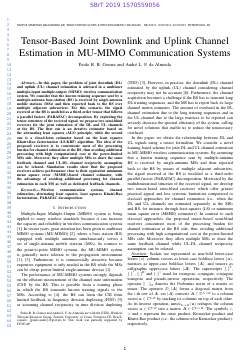
Tensor-Based Joint Downlink and Uplink Channel Estimation in MU-MIMO Communication Systems
Paulo R. B. Gomes, André de Almeida
DOI: 10.14209/sbrt.2019.1570559056
Evento: XXXVII Simpósio Brasileiro de Telecomunicações e Processamento de Sinais (SBrT2019)
Keywords:
Abstract
In this paper, the problem of joint downlink (DL) and uplink (UL) channel estimation is adressed in a multiuser multiple-input multiple-output (MIMO) wireless communication system. We consider that the known training sequence sent by a multiple-antenna base-station (BS) is received by single-antenna mobile stations (MSs) and then reported back to the BS over multiple adjacent subcarriers. For this scenario, the signal received at the BS is modeled as a third-order tensor that follows a parallel factors (PARAFAC) decomposition. By exploiting the tensor structure of the received signal, we propose two semi-blind receivers for the joint estimation of the DL and UL channels at the BS. The first one is an iterative estimator based on the alternating least squares (ALS) principle, while the second one is a closed-form estimator based on the least squares Khatri-Rao factorization (LS-KRF) algorithm. The idea of the proposed receivers is to concentrate most of the processing burden for channel estimation at the BS, thus avoiding additional processing with high computational cost at the power-limited MSs side. Moreover, they allow multiple MSs to share the same feedback channel and UL-DL channel reciprocity assumption can be relaxed. Simulation results show that the proposed receivers achieve performance close to their equivalent minimum mean square error (MMSE)-based channel estimator, with the advantage of avoiding additional processing for channel estimation in each MS as well as dedicated feedback channels.Download